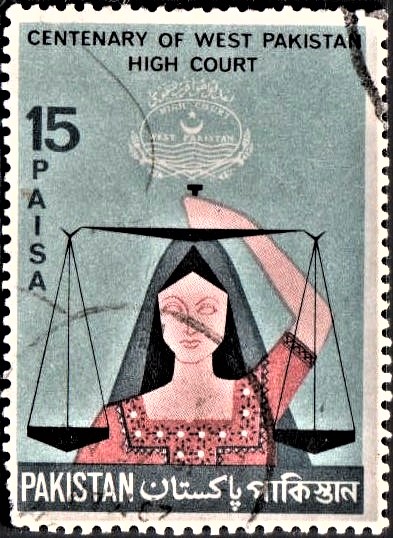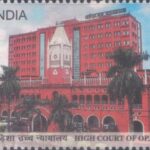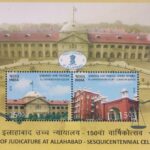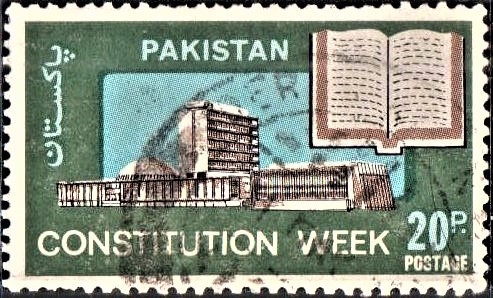
Supreme Court of India 1999
A commemorative postage stamp on the Golden Jubilee of the Supreme Court of India :

 Issued by India
Issued by India
Issued on Nov 26, 1999
Issued for : A proper functioning of the Supreme Court is of vital public importance. The Rule of Law, fundamental rights of the people and a proper functioning of the various constitutional authorities depend on it. The completion of fifty years of the Supreme Court is thus a special occasion for the citizens of this constitutional democracy and the Department of Posts is proud to associate itself with the event through the issue of this stamp.
Credits :
Stamp, FDC & Cancellation : Shubhra Verma Bhatnagar
Type : Stamp, Mint Condition
Colour : Multi Colour
Denomination : 300 Paise
Overall size : 4.06 x 2.73 cms.
Printing size : 3.71 x 2.38 cms.
Perforation : 13 x 13
Paper : Imported unwatermarked Adhesive Gravure Coated Stamp Paper in Sheets 50.8 x 53.5 cms.
Stamps Printed : 0.7 Million
Number per issue sheet : 40
Printing Process : Photogravure
Printer : India Security Press, Nashik
About :
- After independence, when the new Constitution of India came into force, Article 124 provided for the establishment of the Supreme Court of India as the highest Court of the land. On 28th January, 1950, the Supreme Court of India was inaugurated in the Court House, New Delhi. Today the sanctioned strength of the Supreme Court is 26 Judges, with the seniormost Judge as the Chief Justice.
- The Supreme Court of India enjoys various types of jurisdictions, and is considered one of the most powerful courts in the world. The Supreme Court, as the highest constitutional court of the land, is entrusted with the power of judicial review. It can examine legislation by Parliament or by other State Legislatures as well as executive action to ensure that the legislation is within the legislative competence of the concerned legislature and to ensure that the principles of natural justice are not violated by the executive while arriving at its decisions and that a decision which is challenged, is not arrived at mala fide or in an arbitrary manner.
- It is the highest Appellate Court of the land. An appeal lies to the Supreme Court from any judgement, decree or final order of a High Court, whether in a civil, criminal or other proceeding, if the High Court certifies that the case involves a substantial question of law as to the interpretation of the Constitution. In addition, the Supreme Court also has, under Article 136 the right to grant special leave to appeal from any judgement, decree, determination, sentence or order in any case or matter by any court or tribunal in the territory of India. The Supreme Court also has Original Jurisdiction in disputes between the Government of India and any one or more States. The Supreme Court has Advisory Jurisdiction under Article 143 of the Constitution. If, at any time, it appears to the President of India that a question of law or fact has arisen, which is of such public importance that it is necessary to obtain the opinion of the Supreme Court, he may refer such a question to the Supreme Court for its opinion. The Advisory Jurisdiction of the Supreme Court, though not binding, is meant for enabling the Government to obtain an authoritative legal opinion on a matter of public importance. The Supreme Court also has the power to review its own judgments and orders.
- The most important power of the Supreme Court, however, is the power to issue writs in the nature of habeas corpus, mandamus, prohibition, quo warranto and certiorari for the enforcement of the fundamental rights granted under Part III of the constitution. The right to move the Supreme Court for the enforcement of fundamental rights is itself a fundamental right.
- The Supreme Court has also opened new avenues of access to justice for those who were not earlier in a position to move the Court because they suffered from various handicaps such as poverty, lack of adequate knowledge of the law and its procedures, and other disabilities. The Court has now evolved what has come to be known as “public interest litigation” which enables a third party to move the Supreme Court on behalf of such persons for obtaining a redressal of their grievances. In the exercise of such jurisdiction issues of national importance like environmental protection and human rights violations have come before the Supreme Court.
- Altogether, a heavy responsibility has been placed upon the Supreme Court under the Constitution. It receives annually about 35,000 cases for consideration. Yet today, the Supreme Court has only 20600 (approx) pending cases. This was achieved through computerisation, classification of cases and proper court management of the case-load.
- Text : Based on material supplied by the Supreme Court of India.








[…] With his rapier-like arguments, he prevailed upon the Full Bench of thirteen judges of the Supreme Court that the Constitution of India which guaranteed fundamental freedoms to the people, was supreme and […]
[…] alumni have been Vice-President of India, Prime Ministers, Chief Justice of Supreme Court, Members of Parliament, holders of Bharat Ratna, Fellows of Royal Asiatic Society and numerous […]
[…] It also provides for the machinery necessary for the purpose. In this context, the decision of the Supreme Court in Satwant Singh Sahwney vs. the Union of India in 1966 was a path-breaking judgment. Prior to this […]
[…] of “Constantia” for academic pursuit was followed by years of litigation till an order of the Supreme Court in 1841 laid down a scheme for the establishment of La Martiniere College, Lucknow. On 1st October, […]
[…] He was also the first constitutional agitator in this country and drew up a memorial to the Supreme Court and a Petition to the King-in-Council against the Press Ordinance passed in […]
[…] of India in consultation with the Chief Justice of India, constituted a Special Bench of the Supreme Court of India consisting of Justice Mehar Chand Mahajan, Chief Justice of India, Justice S.R. Das and […]
[…] October 1948 Sh. Mahajan took the oath of office as a Judge of the Federal Court later known as the Supreme Court when the Constitution of India came into force on 26th January 1950. Justice Mehr Chand Mahajan […]
[…] of India is the Visitor, the Vice-President is the Chancellor and the Chief Justice of the Supreme Court of India is the Pro-Chancellor of the University. Beginning with three colleges and 750 students, […]
[…] legal luminaries and many of them have adorned bench of Hon’ble High Court and Hon’ble Supreme Court with […]
[…] a significant endeavour undertaken by the Shri Ram Janmbhoomi Teerth Kshetra Trust, formed by the Supreme Court on November 9, […]